Director Sara Dosa on ‘Fire of Love’
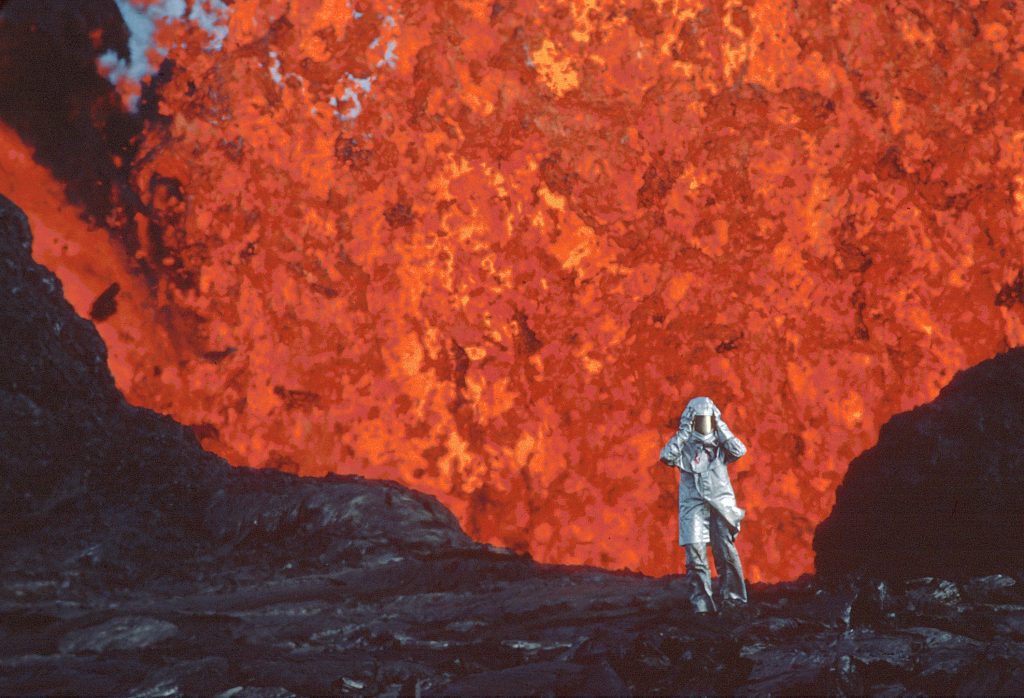
Fire of Love tells the larger than life love story of Katia and Maurice Krafft, the French volcanologist couple who lost their lives in a volcanic explosion in 1991. Using the Kraffts’ remarkable archive of decades of research, the film celebrates the quest for the unknown and the beauty of human relationships with nature. It premiered at the 2022 Sundance Film Festival and won the Jonathan Oppenheimer Editing Award for editors Erin Casper and Jocelyne Chaput. It was named as the top documentary out of Sundance by IndieWire in a survey of 135 critics and is nominated for an Academy Award as a Best Documentary Feature.
Director Sara Dosa is an Independent Spirit Award-nominated documentary director and a Peabody award-winning producer. She is a graduate of Wesleyan University and holds a master’s in anthropology and international development economics from the London School of Economics. In 2018, DOC NYC included her in the inaugural “40 Under 40” class of documentary filmmakers and she was inducted into the Academy of Motion Picture Arts and Sciences.
FRONTRUNNER speaks with Dosa about the meaning of time and legacy, materiality and myths, and the relationship between research and art.
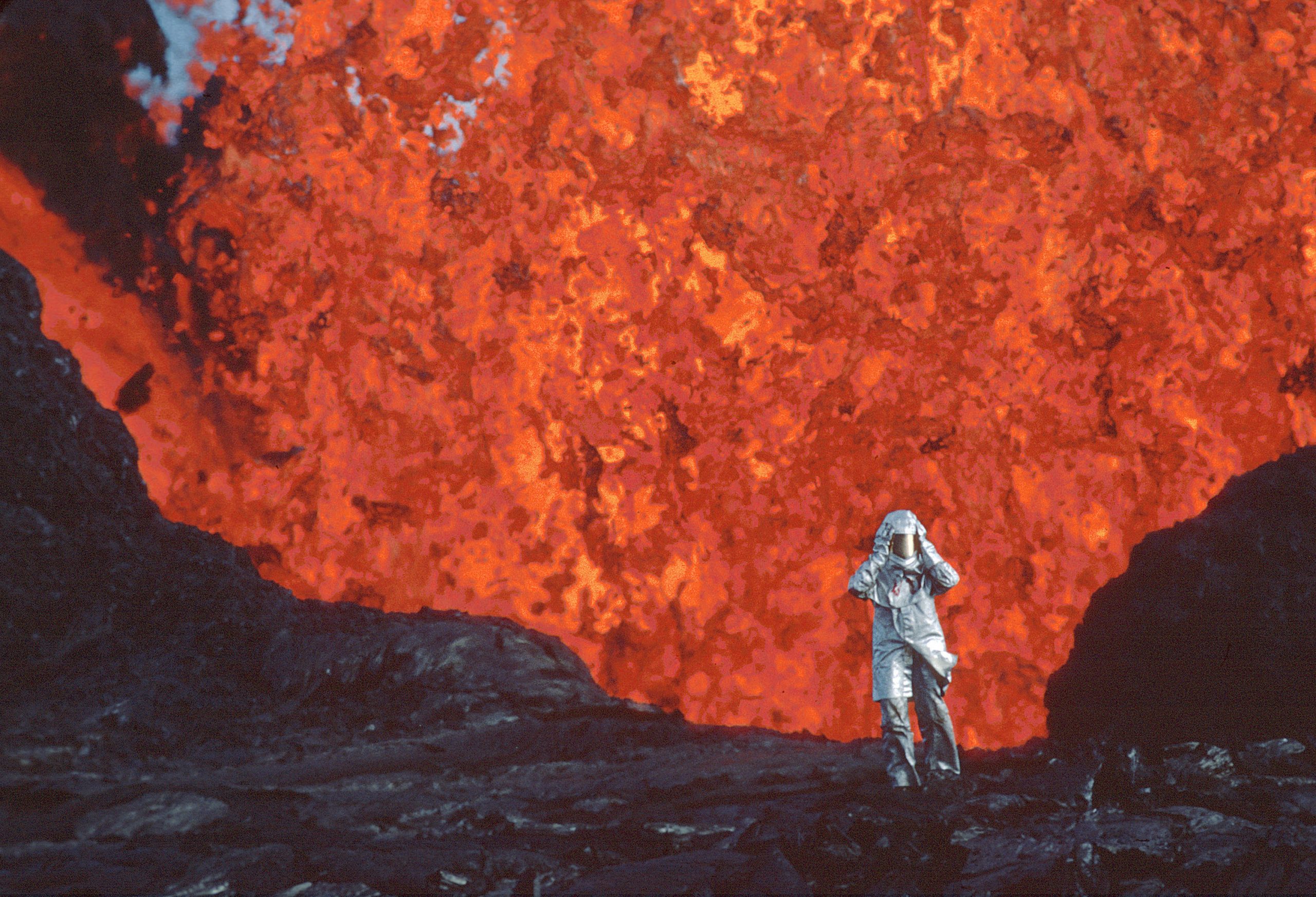
Credit: Image’Est
What drew you to the story?
I first learned about Katia and Maurice Krafft when I was doing research for the last film I directed. That film was shot in Iceland and we were looking for archival imagery of erupting volcanoes in Iceland for one of the scenes in that film. That’s how I first stumbled upon them. There are not that many people who have filmed erupting volcanoes in Iceland, especially archival footage, footage from the seventies, and that was what we were looking for. Their imagery was just spectacular, but it was really once we learned about them as people, we became hooked; Their individual characteristics, how funny and playful they were, but also how philosophical and wise they were. They were scientists, but they were also public intellectuals in France. They had quite a legacy, it seemed. Getting to work with that legacy, both the material that they shot, as well as their imprint on the visual record, seemed like a really exciting and creative challenge for us. That’s how we got the ball rolling, so to speak.
What was the writing process like?
The writing process was always quite challenging, but also turned into one of the most exciting and interesting parts of the film. There are a couple of different phases to it. First, one of my producers, Shane Boris, and I went on a writing retreat at the very beginning of the process. We had done some research and we knew we wanted to tell a love story, that was going to be our particular take on the film. That was mostly because of a sentence in a book that Maurice wrote where he says, ‘For me, Katia and volcanoes, it is a love story.’ And that became our thesis, those words from Maurice. Not just a love story, but a love triangle. With that love triangle idea in mind Shane and I wrote a very thorough outline for the film based on their adventures. They went on nearly 60 expeditions around the world, so we had to pick and choose what made the most sense and what felt like it could fall within this love triangle story. That part of the writing process served as an initial map for the film. But we [also] wanted narration for the film early on. First, we wanted it to only be Katia and Maurice’s voices, but the archive was so limited that we realized if we were going to tell a love story, and specifically a character driven love story where you really got to know Katia and Maurice, we needed another narrative vehicle to do that kind of work. The 16 millimeter footage that they shot, for example, didn’t have any sync sound. And in the other recorded material, where you do hear their voices and see them together, there were all kinds of issues with the footage that made it very challenging to work with. We wanted to write narration that could tell the story of their life in a way that would provide some depth, but also reflect their playful spirit, because they themselves were so playful. We also wanted a very curious voice for our narration, because again, they are searching scientists who are after all of these questions about the unknown. That helped us to guide our own writing; Trying to embrace their way in the world as scientists and as artists and filmmakers, but to lean into what we didn’t know, rather than to try to pretend that we had all the facts. It was very collaborative. My two editors Erin Casper and Jocelyne Chaput, one of my producers, Shane Boris and I, the four of us wrote the narration altogether.
Was there anything you were surprised to find while going through the footage of the Kraffts?
We were constantly surprised looking through their footage, by the majesty of their footage, just how close they got. It still shocks me when I see the imagery, when I look and understand the proximity that they were in with regards to these erupting forces. But also, I was so surprised by the unmistakable love behind the camera. They were engaged in this kind of portraiture of the earth where you feel close. You can feel the love behind their frame and the earth always seems so alive with their lens. I remember the very first images I saw of theirs were of very up close bubbling lava from Hawaii, and it just felt like a monster. Not a scary monster, but this alive being that was shapeshifting and twisting and turning into new forms and hardening into land. To see that process of creation you couldn’t help but feel like it had some sort of supernatural force to it. It made me really understand why there are so many myths and stories about volcanoes as gods. Then there was another set of footage that we would come across when we were going through everything, of things that weren’t volcanoes. They were incredibly surprising to us, just constant surprises and delights. It would be scraps of life that we just didn’t have reference points for. For example, Katia hobbling on one foot with a bandage around her knee, opening a refrigerator, and it would just be 5 seconds of that. We had so many questions about that, ‘What was that? Did Katia get hurt? Where is she?’ but it was just that shot and nothing else. Then there were 2 minutes of a Komodo dragon eating a dead animal in Indonesia. And we were like, ‘Why do they film that? Of course it’s amazing and strange and terrifying, but why? What was it about this? Who shot this and why?’ Those kinds of questions. No matter how much research we did, no matter how many people we spoke to, who actually worked with them and knew them, we couldn’t find some of those answers. But we tried to embrace those unrequited questions as part of the process, almost of scientific inquiry itself. Katia and Maurice had all these questions that they could never answer about volcanoes, yet they still sought to understand. And for us as a filmmaking team, there were so many questions we could never answer that were there in their visual record, but we had to embrace the mystery that we could never quite fully understand ourselves.
The acknowledgement that there was so much more to the story, but that was the story that you chose to tell made the watching experience very special. You mentioned the godly aspects of the volcanoes. The shift between the Kraffts’ love story and their love for the volcanoes, their chasing of the fire, reminded me of the myth of Daedalus and Icarus.
Absolutely. It’s great that you brought that up because we were thinking a lot about myths and the tropes of myths, and Katia and Maurice as these mythic characters. We think that they thought of themselves like that, too. They were very savvy storytellers, and Maurice especially was known to be quite a showman. They would perform ‘the legend of Katia and Maurice’s Krafft’. It never felt inauthentic, it always felt like a true version of them, but they knew that they were characters that were larger than life, so to speak. And I think that’s why, for example, at the beginning of the film, we say that there are discrepancies in the story of how they met. That makes me think of the way people tell tall tales of people that are so larger than life that you can’t help but speculate and wonder, and tell these different stories about how they came to be. That was something that was really interesting to us. It might seem oxymoronic to think that there’s a true myth, but they feel like the embodiment of mythic characters. A myth feels very true in terms of telling their story, if that makes sense.
Were there any aspects of the Kraffts approach for filmmaking or storytelling that you think you would take into your next project?
Oh, definitely. The Kraffts were beautiful artists. Maurice says in the film, ‘I’m not a filmmaker, I just make films in order to wander’. But he, of course, was a brilliantly talented cinematographer and Katia was an exceptional photographer. There is a lot in terms of portraiture, image and composition that I’ve learned from them in the techniques of the craft of filmmaking. But I’m so moved by their constant quest to understand time. Whether it’s geologic time, the lifespan of a volcano that is millions of years set against the fleeting, the precarity of a human life which can be over in an instant. And also how that shows up in their own art. Celluloid, working in film, is a medium that approximates immortality, so to speak. You’re setting an instant ephemeral moment to eternity by working with cameras in the way that they did. And for them, they were capturing these moments that will never happen again. The volcanic phenomena that they were working with will never happen the same way twice, yet they’re recording it for posterity, for scientific study. There is something so beautiful and artful about rendering those kinds of moments and literally creating land. Thinking about time and creation and the mode of film, the role within it, and specifically 16 millimeters, what they were working on, those are all things that I’m fascinated by and would love to explore in the next project that I work on. I’m not sure how, but I’m curious about the idea of a time travel documentary. I have no idea what it would be but I’m intrigued to figure it out.
It sounds incredible, I am looking forward to it! The film also has beautiful animation that complements the remarkable footage. What was the process of working with animator Lucy Munger like?
Lucy is an incredibly talented animator and it was wonderful working with her. From the beginning of the project we knew we wanted some animated sequences, specifically because we wanted to communicate the dreaminess and the whimsy that comes with falling in love. Maurice and Katia fell in love over research as university students. They each had these little moments in the field, but they dreamed of going out into the field together, but first and foremost, learning about volcanoes from books. We thought that some sort of paper world could help to communicate that story of falling in love well. They also, later in life, collected thousands of illustrations of volcanoes that were quite scientific but also whimsical. [There are] these amazing drawings from the 1600s all the way up until the early 1800s that feel almost psychedelic but were scientific at those times. There was a scientist philosopher called Athanasius Kircher, who in the mid 1600s was drawing all of these models of how he thought volcanoes functioned. He believed that there were dragons inside the earth, and the dragons were breathing fire through all these channels. That was science at the time, but it is so whimsical and mythic. Those were kinds of the initial inspirations for the bass plates for the animation that we were working with. Lucy took those textures, that paper world, and manipulated them beautifully in a way that felt in line with the imagery that Katia and Maurice were drawn to themselves. We see this as a collage film. We didn’t want the animation to overwhelm Katia and Maurice’s own imagery, but as a collage film, specifically as an archival film, we thought having that little texture could continue to elevate the idea of collection and the accumulation of a materiality that spoke to their lived experience.
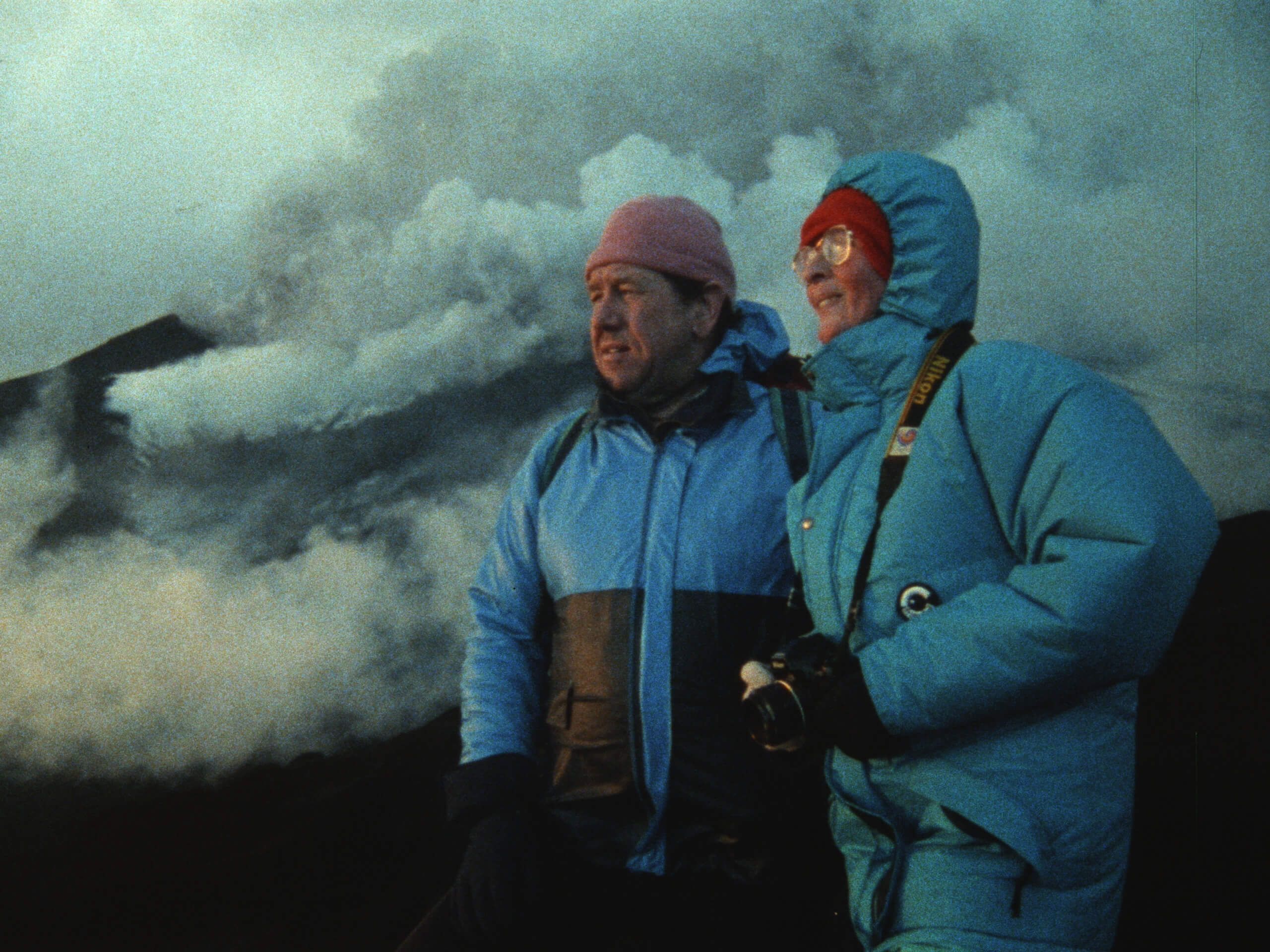
Credit: Image’Est
The film also has a remarkable score and now that you mentioned collage, I feel like the score reminded me of a collage of sounds. What was the process of working with composer Nicolas Godin like?
It was great working with Nico. He is one half of the duo of Air, the French pop band that was really popular in the nineties. Before we started working with Nico, we wanted ‘a retro futuristic score’, was how we put it. I always thought of it as dreaming of the future, but from a vintage past, if that makes sense. A lot of that was inspired by the fun space age type helmets that they wore. It almost felt like a sci-fi B-movie aesthetic that they themselves were embracing. We thought that that kind of score could playfully bring out that style and that aesthetic trend. We also wanted heavy French influences. When we started brainstorming bands that could do that, Air came to mind. We reached out to Nico and he actually grew up watching the Kraffts on television. He knew them very fondly and had that personal connection, and he wanted to work on the film. But you’re right, the score is a collage. We wanted to work with historical French songs as well that could have been things that Katia and Maurice were listening to. That’s why we have a number of French pop songs that were popular in the sixties and seventies that for us added a measure of historicity to the soundscape.
Maurice Krafft mentioned his relationship with academia, criticizing it and being somewhat against the old models of classification. As you mentioned, they were intellectual public figures and Maurice said that he is making films in order to maintain his research and being around volcanoes. As someone with a background in academia yourself, has it affected or shaped your filmmaking?
That’s a great question. That’s what I’m actually constantly asking myself. I thought for a long time I would be a professor of cultural anthropology. My mother, she’s now retired, but she was a professor of anthropology, and my whole life I was fascinated by these anthropological frameworks that really looked at how humans make meaning, form relationships with each other; As well as systems of power, and how humans can construct, navigate and reform relationships of power, specifically in relationship to nature. A specific area of study of mine was about the imaginations of landscapes and how economic discourses would reconfigure relationships to the land. I’m going to stop myself before I go on a huge tangent about my graduate work. But I think that a lot of those questions, specifically about how humans make meaning and form relationships with nature, will always drive my curiosity as a filmmaker, and I do hope that my films will tell stories about the sentience and the power of nature in an effort to rewrite these very dangerous stories about the earth as dead or a resource to be exploited or capitalized upon. I feel like Fire of Love is not overtly political, but I do think that there is a story about the aliveness of the earth that I hope can counteract, again, these dangerous ideas of the earth as just for human usage.
Following one of the deadly volcanoes Katia says- “In the 18th and 19th centuries there were big disasters with many victims, often due to lack of information, but how is it possible in the 20th century when everyone knew?” It can be borrowed for so many things that are going on in the world, and I think this film is another way to expose, like you said, people to the world that they are such a small part of.
Yes, that’s something we’re hoping would resonate with contemporary audiences. That particular moment you’re talking about happened in 1985, but it absolutely echoes with the climate crisis today. Since the nineties, people have been very vocal about this oncoming crisis that we’re now living every day. People are dying from it all around the world and scientists have been sounding the alarm for decades. Yet political and economic justifications are obfuscating meaningful action and in so many ways that could actually turn the necessary tides. I’m also going to stop myself from going on another tangent, but all to say that we’re hoping that echo with what happened in Colombia in 1985 with the Nevado del Ruiz eruption could resonate with some of the calls that scientists, and people who live in relationship with the earth, not just scientists, have been making for some time.
Are there any contemporary creators that inspire work?
There are so many. Miranda July is a huge inspiration. We worked with her as a narrator, but she’s an artist who I will always look to for her curiosity and wisdom, and way of illustrating the strange beauty of human relationships. I think Miranda is absolutely incredible. One of my favourite writers is an American writer, Rebecca Solnit. She’s not a filmmaker, but her work is extremely influential to me. She writes about eco criticism, feminism, politics. She has quite a lyrical way of tying together all kinds of things that might not seem like they naturally go together, but she draws such poignant connections between things. The way she writes, and what she writes about is hugely meaningful to me. One film that I really want to celebrate is a film called Faya Dayi by Jessica Beshir that came out last year, which is a gorgeous poem of a film. It’s quite sensory in its approach and ethnographic in a really beautiful, complex and intimate way. I love that film. I could keep rattling off, but maybe I’ll leave you with those.
Thank you. What advice would you give to young creators who aspire to make a career in filmmaking?
It’s so hard to work in film, but if you love it you just have to go for it. I know that might sound cheesy. For me, things that have been incredibly useful have been building meaningful relationships with people who can be mentors, supporters and collaborators. Finding the people you trust and admire, tending to those relationships with respect and reciprocity have given me such meaning in my own work, but also have been incredibly important. I very much worked my way from a PA to an AP. I always wanted to be a director or a cinematographer, but it was so hard to get my first directing gigs and I had to prove myself as a producer first. But I think learning from people and building a strong community is the thing that has helped me the most. And also it’s just been the most rewarding to have those kinds of friendships. I would say seek out your people and treat them well, and also make sure you are treated well because it’s an industry that can be quite exploitative. It’s hard to advocate for yourself, but I think you can do so in the right ways that also acknowledges the ecology of things, the community that you’re within.
You mentioned a time travel film in your future. Are there any dream projects or dream collaborations you can discuss?
It might sound cheesy, but I want to keep collaborating with my collaborators that I worked with on Fire of Love. This is the third film I’ve worked on with Erin, one of my editors. Jocelyne, my other editor, is new to this project, but I adore her and always want to keep working with her. Shane, one of my producers, and I have worked on six films together. All to say that I of course welcome new collaborations, but I also feel so lucky to have had wonderful collaborators.I don’t have a concrete next project that I’m moving forward on yet. But these things, the human relationship with nature, the sentience of nature, playing with ideas of time and allegory, are all ingredients for future projects. Shane and I were talking the other day; We were having a brainstorm session about future projects and we were saying how we so want a next film to capture the same transcendence and that feeling of utter magic and majesty that images of volcanoes give you. We were trying to think (about) what else can give us that kind of feeling that is not volcanoes. Music does that, celestial exploration does that, love does that, magic does that. Those are perhaps other realms for us to explore.
I saw that the film is being screened at the AMC in Times Square and I thought how lucky people are to be able to watch it in theatres. The imagery is so, so great it deserves the big screen.
I am so grateful to my distributors, National Geographic and Neon in the (United) States and Dogwoof here in the UK where I am currently. We have such wonderful partners that we’re working with that have been dedicated towards putting it in theatres, and I’m so grateful for that. I think Maurice and Katia too. Just thinking about their images, traveling the world again after 30 years, that makes me so happy. And I think that they would look like that. They dreamed big, so it’s only natural that their images would be on the big screen.

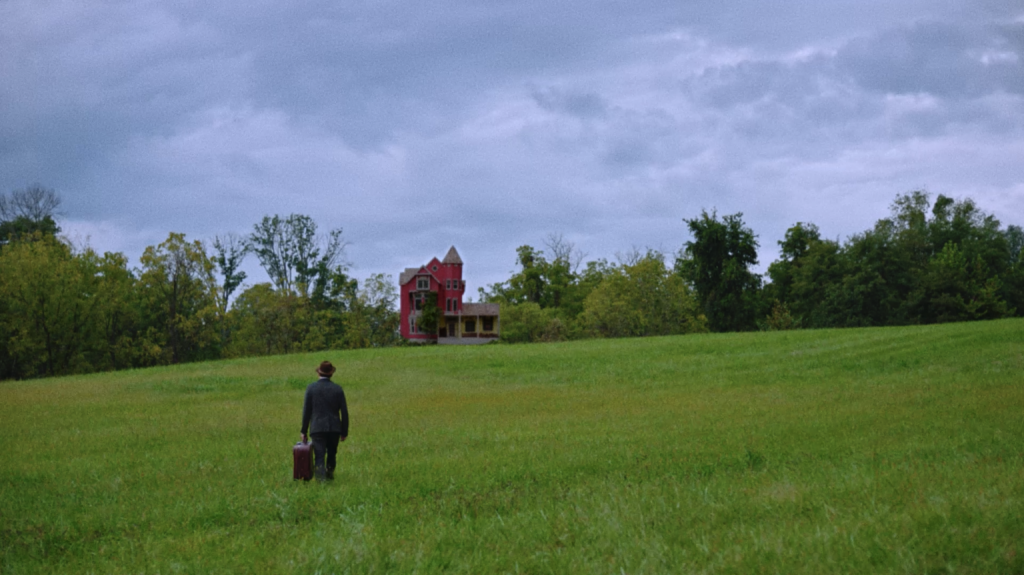

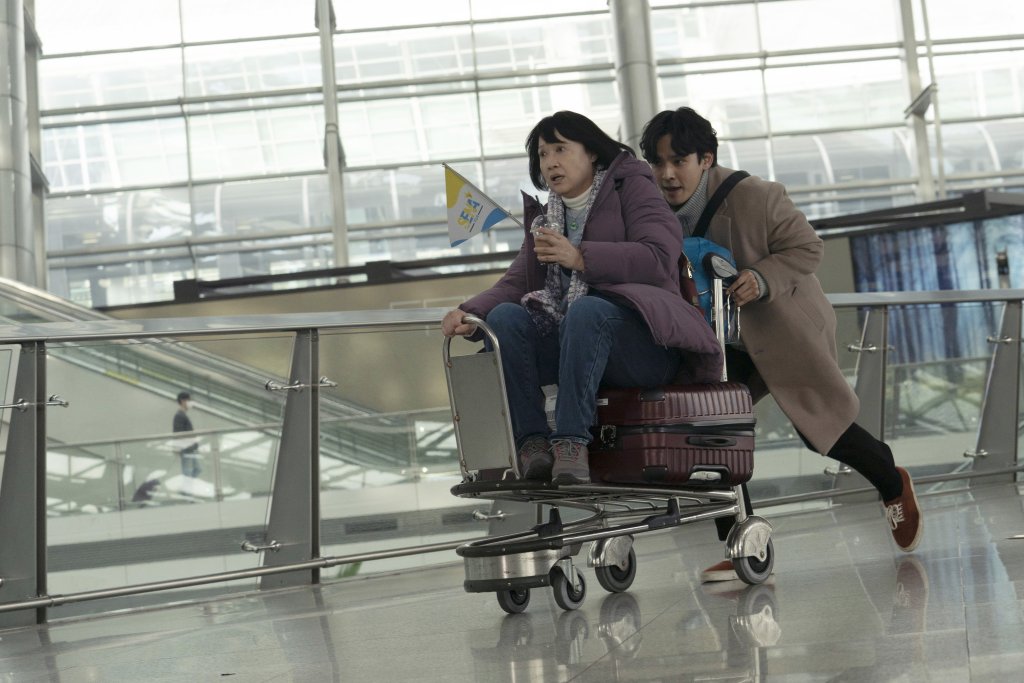
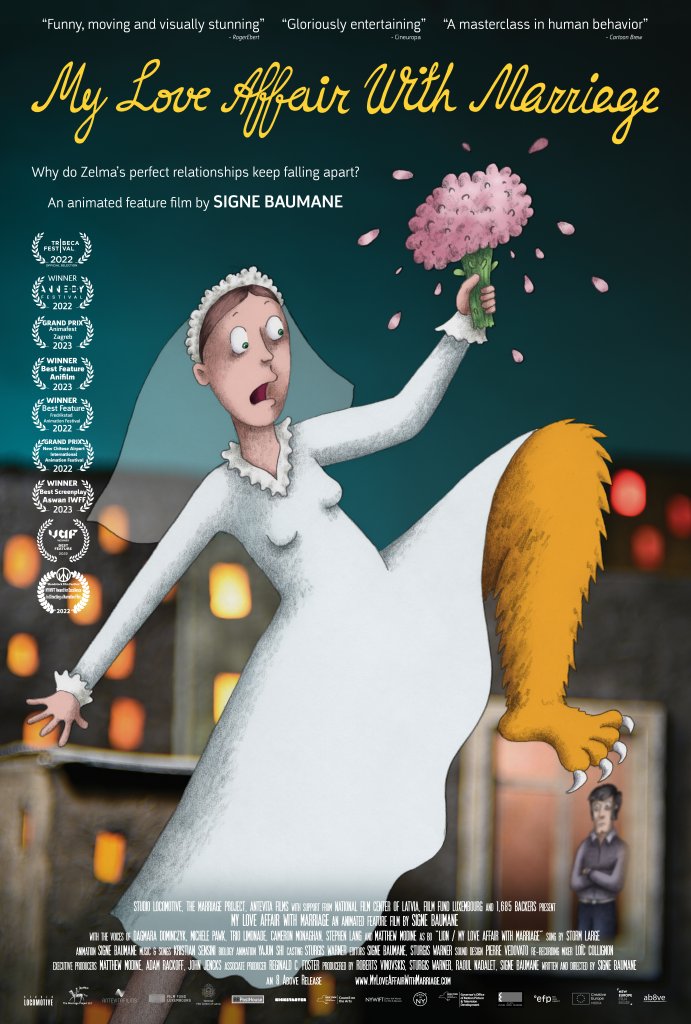
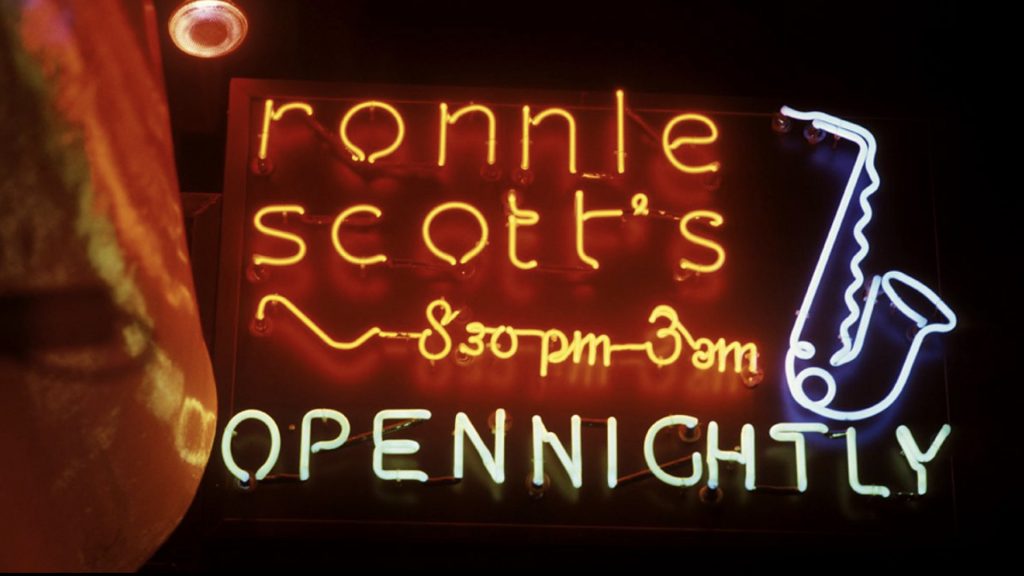
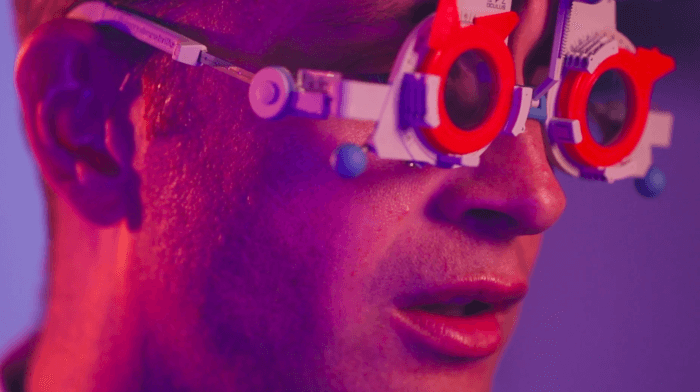
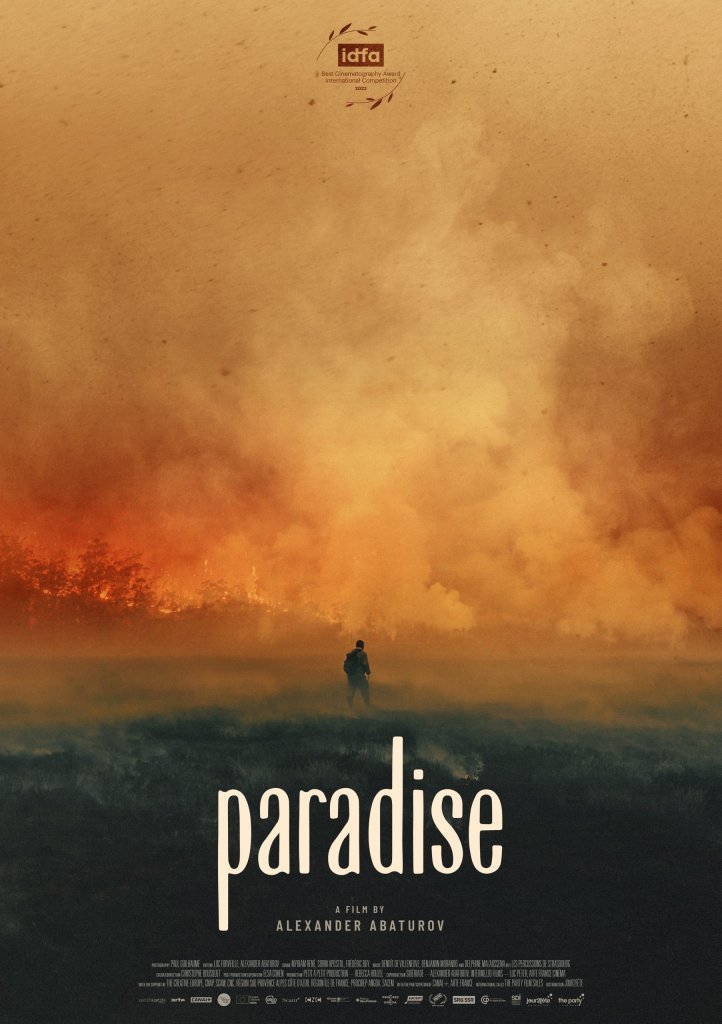


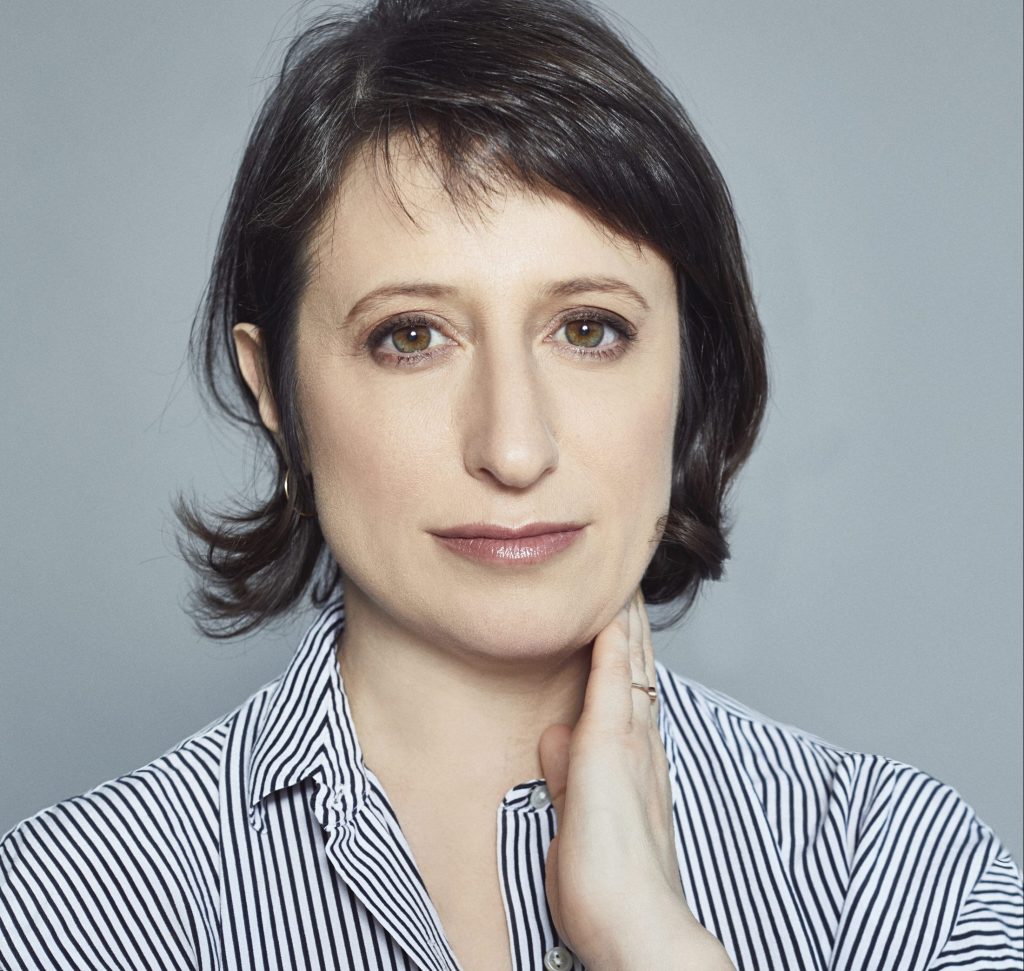
Responses